Though not a common species in tortoise collections, more and more herpetoculturists are discovering the elongated tortoise and inviting them into their lives.
The elongated tortoise (Indotestudo elongata), sometimes called the yellow tortoise, is a personable and curious medium-sized tortoise. Found across a very large natural range that spans Nepal, Bangladesh, India, Myanmar, Laos, Thailand, Cambodia, Vietnam, western Malaysia and southern China, it is called the yellow tortoise by many in Asia because of shell coloration. Shells are typically a pale tannish-yellow to caramel color, with blotches of black on each scute. Coloration and pattern vary, and specimens can be found from a pale yellowish-tan overall to almost solid black. Skin color is also variable, ranging from a creamy yellow to pale gray. During the breeding season, males have a very attractive pink color around their nostrils.
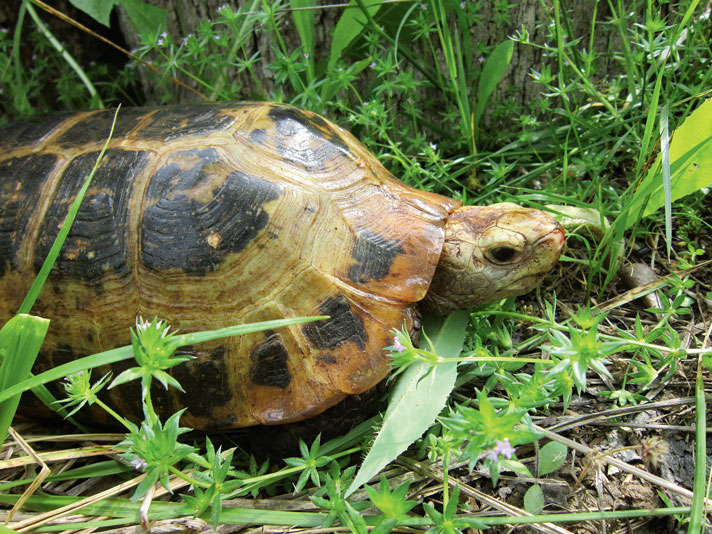
russ gurley
During the breeding season, male elongated tortoises exhibit a very attractive pink coloration around their nostrils.
Captive-bred elongated tortoises are excellent pets as long as you can meet their requirements for warmth and humidity throughout the year. They stay relatively small (12 to 14 inches long), are hardy and long-lived. With some work, and a time period of getting to know you, a pet elongated tortoise will become more accustomed to you and will be inquisitive and less reticent, often approaching to investigate your presence and hoping you have a fresh strawberry or piece of melon to offer.
Elongated tortoises live in warm, tropical forests throughout Asia, and they seem to shun direct sunlight and rarely bask. They spend a great deal of time in the leaf litter and buried in piles of leaves or at the bases of large tropical plants. As you would expect, due to their large geographic range, they are found in a variety of habitats from dry to very humid, and this fact will be an important aspect of their proper care in captivity. A long enclosure that offers a warm, humid area and also a dry area will allow this species to find the right spot for its needs throughout the day and through the seasons.
Elongated tortoises grow to roughly 12 inches long and 7 pounds in weight as adults. Females tend to be wider than males and appear more rounded when viewed from above. The tails of males are longer and thicker than those of the females. Males also have a concave plastron, while the plastron of a female is flat. Interestingly, the nails on the back feet of the females are longer and more curved than those of the males. It is believed that this an adaptation to aid the females while digging nests.
This species is mostly active at dawn and dusk, and like many tortoises, they are inspired by the rainy season in nature and in captivity by the addition of water to their enclosures via misting or spraying. When they get wet, they emerge from the leaf litter to drink, feed, defecate and mate. Elongated tortoises, and most species living in warm areas, are not seasonal breeders. These tortoises can mate and lay eggs at any time of the year.
Indoor Enclosures For The Elongated Tortoise
The most common form of indoor accommodation for small elongated tortoises is a large plastic tub, stock tank or other commercially available enclosure. A 6- to 8-foot-long agricultural stock tank or Waterlandtub medium land enclosures work well for housing a pair of young tortoises or a single adult animal. Of course, as the tortoise grows, it will need a larger enclosure. A pair of adult elongated tortoises will require an enclosure that is at least 4 feet wide by 8 feet long and 1 to 2 feet high.
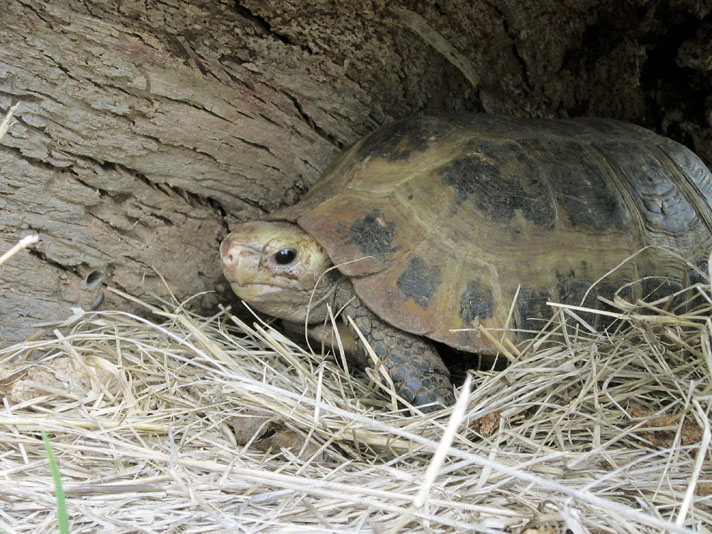
russ gurley
Elongated tortoises live in warm, tropical forests throughout Asia. They spend a great deal of time in the leaf litter and buried in piles of leaves or at the bases of large tropical plants. Pet tortoises can thrive in outdoor enclosures that offer plenty of cover.
For indoor enclosures, I use a mixture of one-fourth sand and three-fourths peat moss as a substrate. I keep it damp but not waterlogged, and the tortoise spends quite a bit of time buried in this damp substrate. A layer of New Zealand sphagnum moss and handfuls of leaves should be placed over the top of the substrate to help hold in moisture. (Bark nuggets and cedar shavings are to be avoided, as they retain toxins and sap that can cause problems for all captive herps.) I also don’t use cypress mulch; it clogs the drains in the pools in my enclosures. However, many tortoise keepers use cypress mulch for their elongated tortoises, red-footed tortoises and other tropical forest species. The substrate can be kept dry if a large water source is provided. This should be a shallow saucer for small specimens and a larger shallow tub or pool for larger specimens. The space underneath the elongated’s favorite shelter should be sprayed with water once or twice a week to keep this area damper than the rest of the enclosure. Young tortoises should be soaked once or twice a week in spring water that only reaches the top of the plastron (about a half inch of water). During this time, they will drink and defecate. Of course, the saucer’s water should be changed any time there is waste in it. I clean all of my small saucer water dishes once a week with a light bleach solution.
Elongates are typically shy tortoises. A keeper should provide a variety of shelters to give them a feeling of security. I add large pieces of curved cork bark, large banana leaves, piles of hay or grass clippings for the tortoises to use as shelter. Shelters should be located at the cooler end of the enclosure and not directly under the heat-emitting lamps.
Indoors, in a cooler home, heat should be provided using a heat-emitting bulb in a lamp from overhead to achieve a basking spot of 90 degrees Fahrenheit at one end of the enclosure. UVB is necessary for vitamin D3 production. As mentioned earlier, these tortoises do not enjoy being kept under bright, hot lamps. So, we offer them heat from a heat lamp and via heat mats under the enclosures but do not place strong UVB-emitting bulbs overheard to avoid damage to the tortoises’ eyes. We fulfill their UVB requirements by placing them outside in a shaded enclosure that allows some sunlight through and indoors, we take care of their vitamin D3 requirements through their food. To make sure they receive the necessary vitamins, we offer diverse salads made from a variety of fruits and vegetables (and a small amount of animal protein in the form of high-quality cat food, soaked monkey biscuits and soaked commercial tortoise diet twice a week) and sprinkle their food with the necessary vitamin supplements. These tortoises will also eagerly accept thawed mice, and these are offered to our adults once or twice a month, especially during breeding season.
Outdoor Enclosures For The Elongated Tortoise
These tortoises benefit from being kept outdoors for all or part of their lives, depending on where you live. They receive doses of UVB radiation, environmental heat and, of course, enjoy a connection to the grass, plants and soil found in outdoor pens. Outdoor enclosures should offer shelter from heat, a secure place to rest and a water source, as these tortoises enjoy soaking and drinking from shallow pools of fresh water. Food can be supplemented by plantings of some of their favorite grasses, fruits and vegetables within the enclosure. A keeper must be very diligent to make sure that outdoor enclosures are escape-proof and predator-proof.
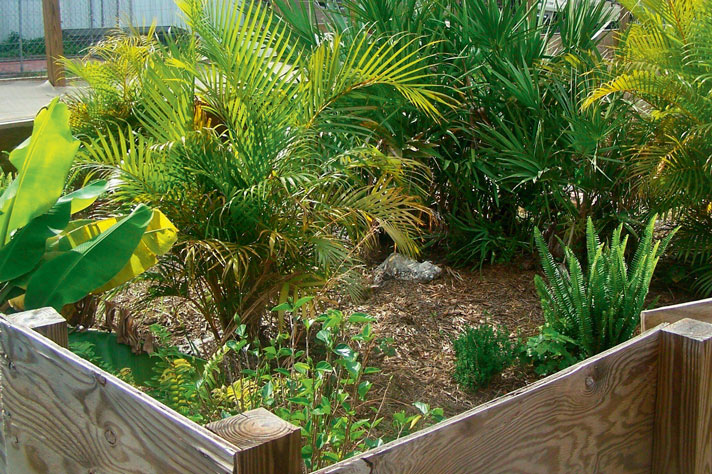
russ gurley
Shaded areas should be located throughout the enclosure to give them some areas away from the heat and other tortoises.
Elongated tortoises thrive in outdoor enclosures or backyards that offer them plenty of brush for cover and a shallow water feature or sprinkler system that can cool them off once or twice a day during the heat of summer. The outdoor enclosure for a pair of adult elongated tortoises should be 6 feet wide by 8 feet long and with walls that are 2 feet high (to discourage climbing and to hopefully discourage any predators). This size enclosure could house another female, but if you want to add an additional male tortoise, you will need to enlarge the enclosure to twice this size and add lots of logs, bushes and shrubs, and areas for the males to keep away from each other.
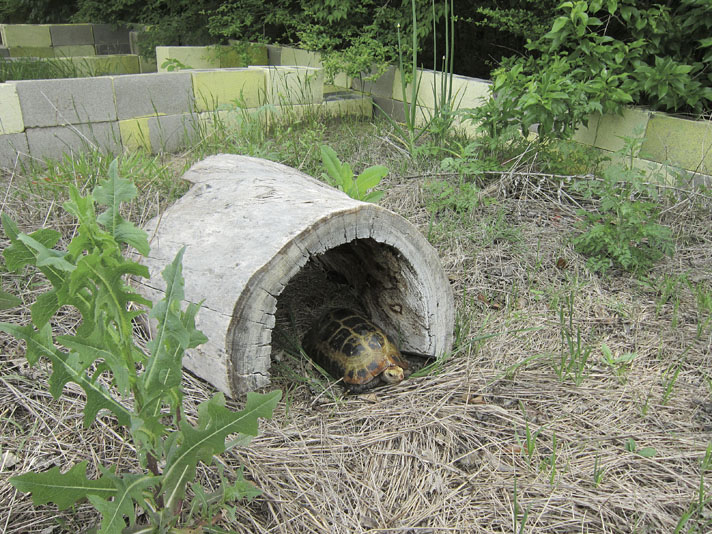
russ gurley
Elongated tortoises are typically shy tortoises. A keeper should provide a variety of shelters to give them a feeling of security.
As the weather approaches 50 degrees, I begin moving them indoors for the winter. I do keep them in the 60- to 65-degree range for December, January and February. This short winter resting period is only offered to adults who are going to be breeding the following spring and summer. They can be kept and bred successfully in the 70- and 80-degree range, but I like the break from constant care and the tortoises tolerate the cool, resting period quite well. During the cooling period, I open a large bale of grass hay in their enclosure, and they spend the three months hiding inside, only venturing out once or twice to get a drink of fresh, clean water.
Breeding Elongated Tortoises
Once elongated tortoises reach maturity, a keeper may wish to try to breed them. If they are a sexual pair, healthy and in a stress-free environment, this shouldn’t be a problem. Male elongated tortoises reach sexual maturity much sooner, and smaller, than females. Males will show an interest in breeding at roughly 4 years old, and females will usually take 6 to 8 years to mature, depending on how much they are fed and whether they are allowed to rest in the winter months.
A light winter cooling of three months (only down into the low to mid 60 degrees), followed by a warm up into the 80s to low 90s degrees, and including some rainy days, triggers breeding in elongated tortoises. Male elongated tortoises have pale to vivid-yellow heads and during the breeding season the area around the eyes and nostrils become flush with an attractive pink coloration.
Want To Learn More?
Elongated Tortoise Species Profile
Males are typically eager breeders, and a healthy pair can produce two clutches of three to five eggs each season, depending on the size of the female. These clutches are typically laid four to six weeks apart. It is felt by most keepers that the addition of protein and calcium to females’ diets is essential in having them produce clutches of healthy, viable eggs. The young tortoises hatch in 100 to 120 days when incubated at 84 degrees.
Elongated Tortoise Health Watch
As elongated tortoises are really only available as captive-hatched babies these days, a keeper should not be concerned about internal parasites. However, it is always good to quarantine any new additions to your collection for up to 90 days to watch for any health-related issues. You might even want to have your veterinarian run a fecal exam for you.
REMEMBER: Ivermectin, a well-known wormer in the cattle industry, will kill your tortoise. You might even remind your veterinarian of this fact, but most will know.
What To Feed Elongated Tortoises
As mentioned previously, elongated tortoises are omnivores, eating both animal and plant material in nature. I offer mine a mixed salad with a base of romaine and/or green leaf lettuce (roughly one head per adult tortoise) and top it off with a shredded mix of 75 percent vegetables (zucchini and yellow squash, sweet potato, carrots, peas, cucumber and green beans) and 25 percent fruit (usually apple, pear and banana) every third day for adults and every other day for hatchlings and tortoises up to about two years old.
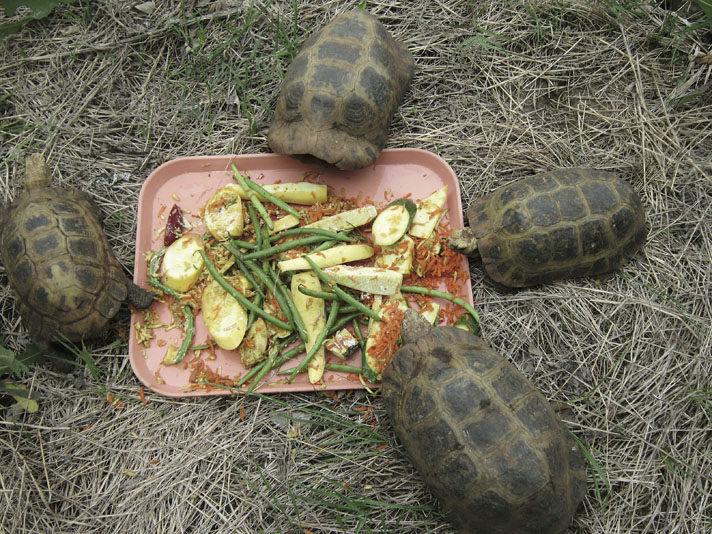
Russ Gurley
The mixed salad is topped off with a shredded mix of 75 percent vegetables, including zucchini and yellow squash, sweet potato, carrots, peas, cucumber and green beans.
During the summer, I offer them watermelon, cantaloupe, peaches and other ripe fruit as a treat. These tortoises scavenge for carrion in nature, and I feed them some higher-protein items once or twice a week. They will eagerly consume thawed mice, earthworms and commercial tortoise foods produced for forest-dwelling species.
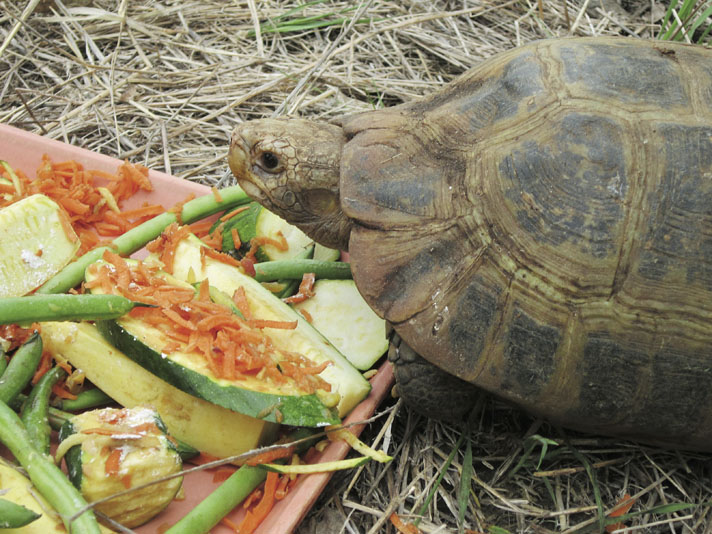
russ gurley
Elongated tortoises are omnivores, eating both animal and plant material in nature.
I add a mixture of roughly 75 percent calcium with Vitamin D3 supplement and 25 percent reptile vitamin powder onto their salads once a month when they are housed outdoors (they are getting direct UVB and browsing on a wide variety of plants and grasses) and every third or fourth feeding when they are housed indoors.
In Closing
Tortoise breeders are having success breeding elongated tortoises, and captive-hatched specimens are available in ever-increasing numbers. Though not a common species in tortoise collections, more and more herpetoculturists are discovering this beautiful tortoise and inviting them into their lives. Should you chose to do so, you won’t be disappointed.
Russ Gurley is the founder of the Turtle and Tortoise Preservation Group (ttpg.org), a conservation group dedicated to saving the world’s turtles and tortoises through captive-breeding programs. The TTPG also hosts an annual conference on captive care and breeding in November each year. Russ is the author of many books and articles related to the captive care and breeding of rare turtles, tortoises and lizards. He was the first private keeper in the United States to breed flat-tailed tortoises (Pyxis planicauda) and tuberculated toad-headed turtles (Batrachemys tuberculatus).


